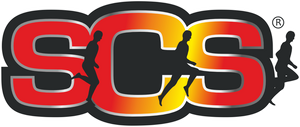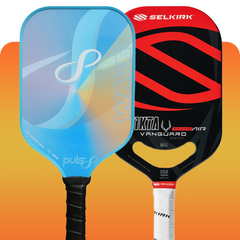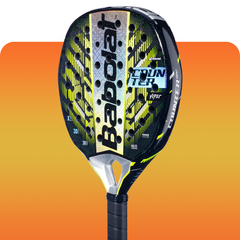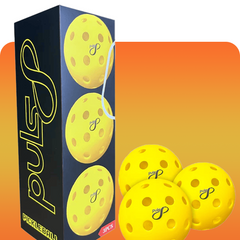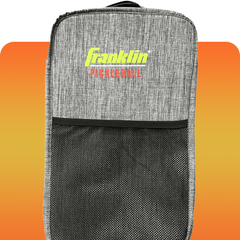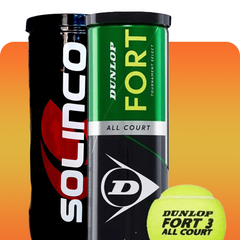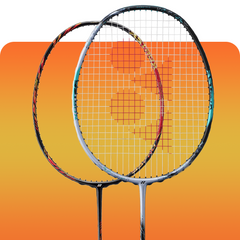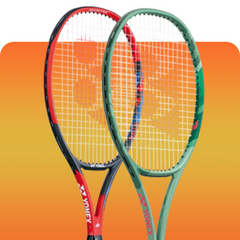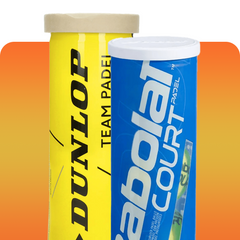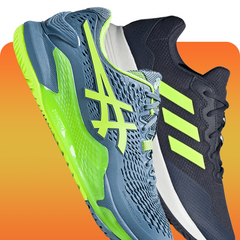Tennis Buying Guide
Find the Perfect Tennis Racquet
Key Racquet Specifications
-
Head Size:
-
Oversized (106+ sq inches):
Provides a large sweet spot, great for beginners needing forgiveness on off-center hits. -
Midplus (98-105 sq inches):
A balance of power and control, suited for most players. -
Midsize (93-97 sq inches):
Geared towards advanced players seeking pinpoint accuracy and control.
-
Oversized (106+ sq inches):
-
Weight:
-
Lightweight (225-275g):
Easy to maneuver, great for beginners or those wanting more swing speed for power. -
Medium (275-300g):
A versatile range, offering both ease of swing and stability for intermediate and advanced players. -
Heavy (300g+):
Maximum stability but demanding on the arm. Mostly suited for very powerful advanced players.
-
Lightweight (225-275g):
-
Balance:
-
Head Light:
Faster maneuverability, favors volleys and quick reactions. -
Even:
Balanced feel for all-around playstyles. -
Head Heavy:
Greater power on groundstrokes, but less maneuverable.
-
Head Light:
-
Beam Width
-
Thin beams:
Promote flexibility, control, and feel. -
Thick beams:
Increase power and stiffness.
-
Thin beams:
-
String Pattern:
-
Open (16x19):
Enables easier spin generation and access to power. -
Dense (18x20):
Provides greater control and feel, suited for advanced players.
-
Open (16x19):
-
Stiffness (RA Rating):
-
Low Stiffness (RA below 65):
More flexible for comfort, arm-friendliness, and power. -
High Stiffness ( RA 65+):
Precise control, but less forgiving and potentially harsh on the arm.
-
Low Stiffness (RA below 65):
Based on Player Skill
-
Beginners:
Oversized head, lightweight, head-light balance, forgiving string pattern, prioritize comfort and power. -
Intermediate:
Midplus head, medium weight, even to slightly head-heavy balance, balance of power and control. -
Advanced:
Midsize head, heavier weights, head-light to head-heavy depending on playstyle, denser string patterns. Customize for precision and spin.
Additional Considerations
-
Grip Size:
A proper grip is essential – too small and you overcompensate; too big and it limits wrist action. -
Material:
Graphite is the standard, but variations in how it's used change feel and performance.
How to Measure Grip Size
Here are the two most common methods to find your ideal tennis grip size:

-
Method 1: The Finger Test
-
Eastern Forehand Grip:
Hold your racquet as if you were about to hit a forehand with your palm on the same flat side of the handle (bevel) as the strings. -
Index Finger Space:
Slide the index finger of your non-dominant hand between the base of your ring finger and the top of your palm. -
Assessing the Fit:
- Ideal Fit: There's just enough space for your index finger to fit snugly.
- Too Small: Your finger doesn't fit comfortably.
- Too Big: There's a noticeable gap between your finger and palm.
-
Eastern Forehand Grip:

-
Method 2: The Ruler Measurement
- Open Hand: Extend your dominant hand with your fingers close together, as if you're giving a high-five.
- Measure: Align a ruler with the bottom lateral crease of your palm (the one closest to your wrist) and measure to the tip of your ring finger.
-
Convert to Grip Size: Use this handy chart:
- 4 inches = Grip Size 4 (or 0)
- 4 1/8 inches = Grip Size 4 1/8 (or 1)
- 4 ¼ inches = Grip Size 4 ¼ (or 2)
- 4 3/8 inches = Grip Size 4 3/8 (or 3)
- 4 ½ inches = Grip Size 4 ½ (or 4)
- 4 5/8 inches = Grip Size 4 5/8 (or 5)
- 4 ¾ inches = Grip Size 4 ¾ (or 6)
Important Notes:
- Starting Point: These methods offer a great starting point. Personal preference plays a role.
- Between Sizes: If you're between sizes, start with the smaller grip. You can always increase the size easily with an overgrip.
- Comfort is Key: The right grip size feels secure without straining your hand.
Based on the Player Skills:
-
Power Players
-
Focus:
Generating raw power to overwhelm opponents with dominant shots. -
Key Racquet Specs:
- Oversized head: Larger sweet spot for power even on off-center hits.
- Lightweight: Enables faster swing speeds for generating greater power.
- Head-heavy balance: Provides additional force behind groundstrokes.
- Open string pattern: Promotes easier power generation.
- Stiffer frame: Transfers energy back to the ball for greater force.
-
Focus:
-
Control Players
-
Focus:
Precision and consistency to manipulate the ball and dictate points. -
Key Racquet Specs:
- Smaller heads (Midsize or Midplus): Increases control and accuracy on contact.
- Heavier weights: Enhances stability for handling opponent's power shots
- Even to Head-light balance: Encourages maneuverability and accuracy.
- Denser string pattern: Provides a tighter string bed for maximizing feel and control.
- More flexible frame: Promotes better touch and feel.
-
Focus:
-
Spin Players
-
Focus:
Crafting shots with heavy topspin to force errors and control the court. -
Key Racquet Specs:
- Midplus to Oversized head: Larger sweet spot provides power with ample forgiveness.
- Medium-weight: A balance of power and maneuverability for generating spin.
- Head-light balance: Helps accelerate the racquet head for spin generation.
- Open string pattern (16x19): Allows the strings to "snap back" for maximum spin.
- Stiffer frame: Gives spin players the necessary powerful response on contact.
-
Focus:
-
All-Round Players
-
Focus:
A versatile player who adapts to any situation on the court. -
Key Racquet Specs:
- Midplus head: Provides a blend of power and control.
- Medium weight: Balance of stability and maneuverability.
- Even to slightly head-heavy balance: Offers adaptability for both power and control.
- String pattern: Typically 16x19 (open) for a mix of spin and accuracy.
- Stiffer frame: Gives spin players the necessary powerful response on contact.
-
Focus:
Find the Perfect Tennis Shoe
Key Factors: Tennis-Specific Adaptations
-
Outsole:
- Durability: Tennis, especially on hard courts, involves more dragging and abrasive movement than badminton. Abrasion-resistant rubber compounds and reinforced high-wear areas are vital.
-
Tread Patterns:
- Hard Courts: Herringbone or modified herringbone patterns for all-around grip, with the depth of the pattern influencing durability.
- Clay Courts: Tightly packed herringbone tread for traction, but designed to allow sliding and prevent clay build-up.
- Grass Courts: Nubbed or pimpled outsoles for grip on a slippery surface.
-
Cushioning:
- Impact Absorption: While jumps occur in tennis, the repetitive side-to-side and forward-backward movement creates different impact stresses. Responsive cushioning is key.
- Technologies: Brands like Nike (Air Zoom), Asics (GEL), Adidas (Boost), and others have proprietary systems for cushioning and energy return.
-
Stability:
- Lateral Support: Tennis involves more aggressive side-to-side movement than badminton. Reinforced side sections, outriggers, and midfoot shanks are crucial for preventing ankle rolls.
- Toe Protection: Dragging toes on serves or hardcourt stops is common. Reinforced toe areas and durable materials are needed.
-
Breathability: Still important, but often a balance is struck with durability needs, especially in the upper. Strategic mesh placement is key.
-
Weight:
- The Balance: Lighter shoes are enticing for speed, but tennis shoes need stability more than badminton shoes. A balance must be found.
Playing Style
-
Baseliners:
Maximum lateral stability, durable outsoles (toe areas specifically), and cushioning tuned for repetitive side-to-side impact. -
Serve & Volleyers:
Lighter weight and greater forefoot cushioning become priorities. Lateral stability is lowered slightly for quicker direction changes. -
All-court Players:
Need a mix of stability, durability, and comfort as situations change constantly.
Skill Level
-
Beginners:
Similar to badminton: emphasize support and cushioning as proper movement is learned. Stability prevents injury. -
Intermediate:
Begin exploring lighter shoes as footwork solidifies. Needs become more specific depending on playstyle. -
Advanced:
Performance becomes paramount. Weight, cushioning technology, and surface-specific outsoles are customized for personal playstyle.
Find the Perfect Tennis Ball
Key Factors: Understanding Your Tennis Ball Needs
-
Pressure vs. Pressureless
- Pressurized Balls: Standard for competitive play. They have an internal air core that gives them their signature liveliness, but they lose this bounce over time.
- Pressureless Balls: Denser rubber construction. They won't go flat, making them great for practice and beginners, but have a heavier feel with less bounce.
-
Felt Types
- Woven Felt: More traditional, durable, and often seen in higher-end balls. Holds up well on abrasive surfaces like hard courts.
- Needle Felt: Softer, fluffier feel. Can wear a bit faster on hard courts, but preferred by some for their initial responsiveness.
-
Skill Level
-
Beginner/Practice Balls:
Prioritize durability with pressureless options being popular. Focus on affordability and longevity. -
Intermediate:
Exploring regular or extra duty pressurized balls, depending on court preference. -
Advanced/Competitive:
Specific brand preferences come into play, focusing on consistent performance and desired feel.
-
Beginner/Practice Balls:
FInd the most Compatible String for Racquet
String Gauge (Thickness)
- Thinner Gauge (17 - 18 gauge / 1.25 - 1.20mm): Prioritizes feel, spin potential, and a touch of added power at the cost of reduced durability.
- Mid-Gauge (16 - 16L gauge / 1.30-1.35mm): The most versatile option, offering a solid balance of power, spin, and durability.
- Thicker Gauge (15L - 15 gauge / 1.35mm - 1.40mm): Maximum durability, often seen in players who frequently break strings. Can feel stiffer and less lively.
String Tension
- Lower Tension (Below 55lbs): Promotes a trampoline-like effect for increased power, but less control. Suits some power-focused baseliners.
- Medium Tension (55-62lbs): A versatile range for most players, offering a good blend of power and control.
- Higher Tension (62+ lbs): Prioritizes control and precision. Requires stronger technique to extract power from a stiffer string bed.
String and Tension Guide Based on Playstyles
Power Players
- String Type: Thin multifilaments or textured synthetics focused on power and spin potential.
- Tension: Lower end of the spectrum, but skill level dictates optimal tension.
- Ideal for: Aggressive baseliners with powerful swings, who can harness the extra pop while maintaining control.
All-Around Players
- String Type: Mid-gauge multifilament or hybrid setups (see below) provide a balance of playability, comfort, and durability.
- Tension: Mid-range tensions offer adaptability for diverse shot needs
- Ideal for: Players experimenting with playstyles, or those with a balanced game without a dominant focus.
Control-Oriented Players
- String Type: Mid-gauge to thicker polyester strings designed for control and durability.
- Tension: Higher tensions provide a consistent, predictable response for precision shot-making.
- Ideal for: Players prioritizing precision placement, touch shots, and consistent groundstrokes.
